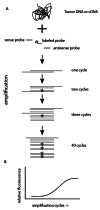HPV-associated head and neck cancer: molecular and nano-scale markers for prognosis and therapeutic stratification
- PMID: 22666080
- PMCID: PMC3355463
- DOI: 10.3390/s120405159
HPV-associated head and neck cancer: molecular and nano-scale markers for prognosis and therapeutic stratification
Abstract
Over the last 10 years, it has become clear that patients with head and neck cancer can be stratified into two distinct subgroups on the basis of the etiology of their disease. Patients with human papillomavirus-related cancers have significantly better survival rates and may necessitate different therapeutic approaches than those with tobacco and/or alcohol related cancers. This review discusses the various biomarkers currently in use for identification of patients with HPV-positive cancers with a focus on the advantages and limitations of molecular and nano-scale markers.
Keywords: biomarkers; head and neck cancer; human papillomavirus; in situ hybridization; next generation sequencing.
Figures




References
-
- Jemal A., Siegel R., Ward E., Hao Y., Xu J., Murray T., Thun M.J. Cancer statistics, 2008. CA Cancer J. Clin. 2008;58:71–96. - PubMed
-
- Brizel D.M. Head and neck cancer. Introduction. Semin. Radiat. Oncol. 2009;19:1–2. - PubMed
-
- Syrjanen K., Syrjanen S., Lamberg M., Pyrhonen S., Nuutinen J. Morphological and immunohistochemical evidence suggesting human papillomavirus (HPV) involvement in oral squamous cell carcinogenesis. Int. J. Oral Surg. 1983;12:418–424. - PubMed
-
- Chaturvedi A.K., Engels E.A., Anderson W.F., Gillison M.L. Incidence trends for human papillomavirus-related and -unrelated oral squamous cell carcinomas in the united states. J. Clin. Oncol. 2008;26:612–619. - PubMed
Publication types
MeSH terms
Grants and funding
LinkOut - more resources
Full Text Sources
Medical

